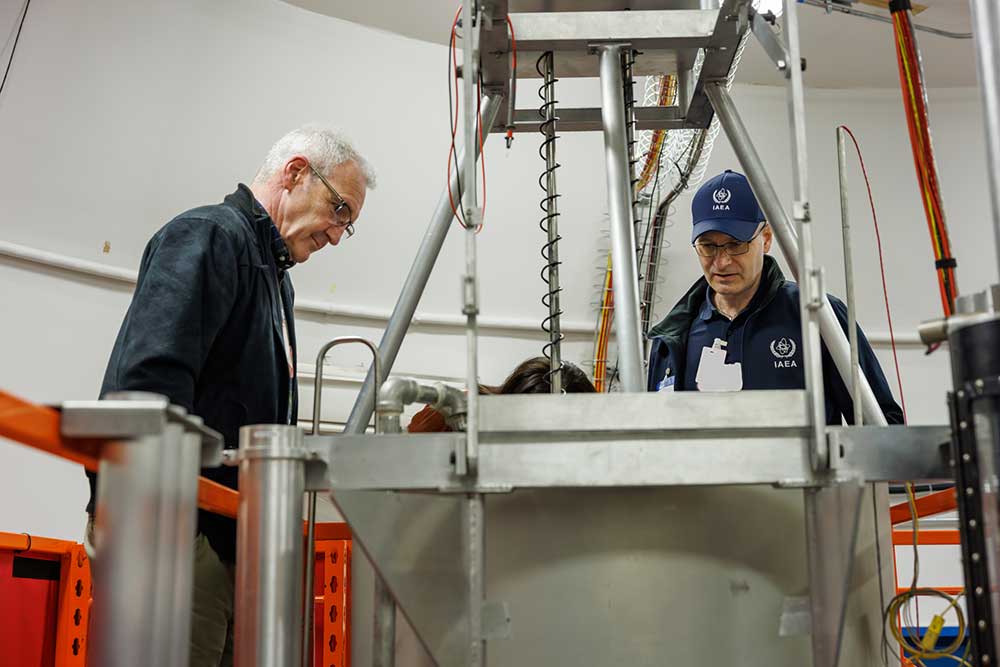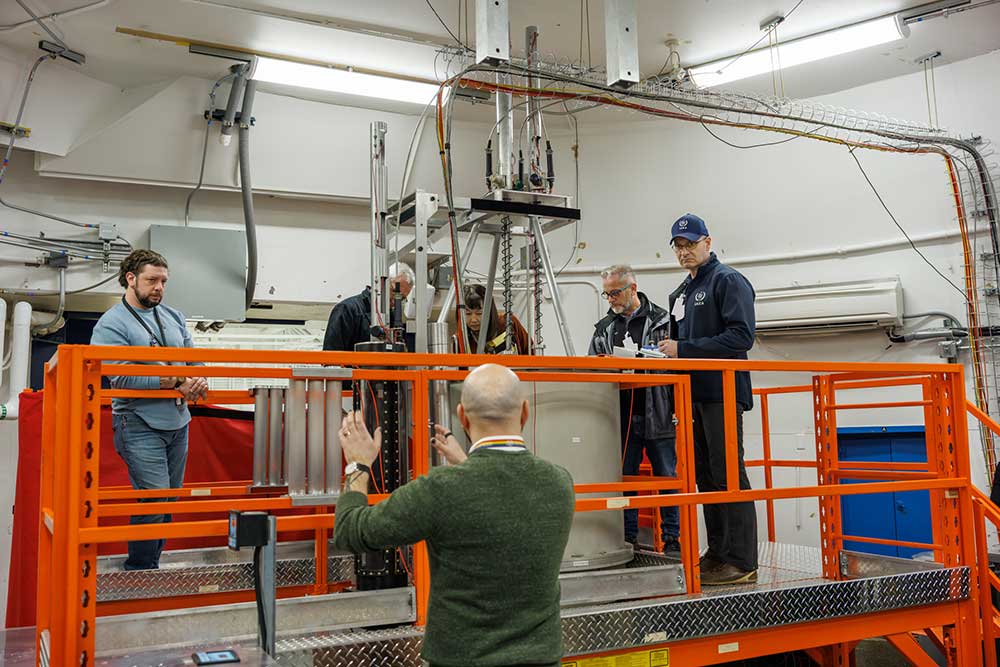
Sandia is demonstrating to the world how serious the United States is about protecting nuclear material. For the second time, the U.S. voluntarily participated in the International Atomic Energy Agency’s International Physical Protection Advisory Service mission, which included a stop at Sandia.
International nuclear security experts from nine countries participated in the advisory mission. The goal was to review how the host country — in this case, the U.S. — is implementing international legal instruments and consensus recommendations for protecting nuclear material and facilities. The instrument is the Convention on the Physical Protection of Nuclear Material and its Amendment, which 135 countries have agreed to follow.
As part of the Feb. 26 to March 8 mission, four of nine advisory service members visited Sandia.
“This was a diplomatic effort and a great collaboration,” said Anita Romero, an engineering program and project lead who works in Global Security at Sandia. “It allowed Sandia to demonstrate how the U.S. is protecting nuclear material and facilities, while getting feedback on areas where we can strengthen nuclear security.”
Anita said about 70 employees from Global Security, Safeguards and Security, Cyber Security, Emergency Management and Nuclear Facility Operations spent about a year planning and preparing for the visit. Sandia staff from various divisions who do not often get to work together provided input, developed materials, briefed mission members and traveled to Maryland to contribute to the mission.
A long history
Sandia’s relationship with the International Atomic Energy Agency dates to the 1970s. On behalf of NNSA, Sandia hosts the agency’s flagship international training course on physical protection of nuclear materials and facilities. More than 1,000 international participants have come through Sandia’s doors for the training since it started in the late 1970s.
“Sandia has a long history of working in the nuclear security field,” said Joe Sandoval, a Sandia technical adviser who helped DOE and NNSA prepare for the mission. “This mission was an important White House initiative based on commitments made during the 2010 and 2016 Nuclear Security Summits. The White House and Congress are very interested in the results.”
Most of the mission was held at DOE in Maryland, and it focused on DOE’s legal and regulatory framework for protecting nuclear material. The mission required the collaboration and coordination of nine offices across DOE and NNSA.
Sandia visit
Out of nearly 200 DOE and NNSA sites in the country, DOE selected Sandia to demonstrate how the legal and regulatory framework for protecting nuclear material is implemented.
“This shows that Sandia takes nuclear security seriously,” Joe said, referring to DOE’s selection of Sandia.
The trip to Sandia included opening remarks from DOE, NNSA and Sandia Field Office representatives, and Deputy Labs Director David Gibson.
“Our roots trace back to the Manhattan Project. We are excited to showcase the Laboratories and the work we do, as we celebrate Sandia’s 75th Anniversary,” David said.
Tapani Hack, one of four International Atomic Energy Agency members who visited Sandia, said he was impressed with the number of Sandians participating in the mission. He said it showed the Labs’ commitment to the agency’s mission and nuclear security.
A culture of security
Sandia’s Safeguards and Security Center played a key role in the mission and preparing for the visit to Sandia. Each day, Safeguards and Security is responsible for protecting Sandia’s people, information, facilities and materials in accordance with DOE and NNSA requirements.
“This mission highlighted the incredible work Sandia performs and revealed a constant commitment to a culture of security,” said Deion D’Arco, who works in Safeguards and Security.
Safeguards and Security led the effort to complete over 130 self-assessment line items to prepare for questions or topics to be reviewed during the visit to Sandia. Additionally, the center coordinated the development of over 160 slides, which Sandia managers used to brief the mission members. Externally, Sandia also partnered closely with DOE and NNSA.
“The opportunity to collaborate with DOE and NNSA representatives, from all levels, has been incredible,” said Paulette Solis, a manager in Safeguards and Security. “These individuals provided monthslong support and coordination in advance of the mission.”
Sandia Pulsed Reactor Critical Experiments Facility
During a walkthrough of the Sandia Pulsed Reactor Critical Experiments Facility, Sandians showed how security measures are implemented.
“We had a short time to demonstrate to mission members — at a very broad level — how we protect nuclear material and facilities,” Anita said. “A lot of our focus in preparing for this mission was coordinating to make this as smooth and easy for the mission members to see as much as possible in a short timeframe.”

Work at the facility focuses on nuclear assembly critical experiments and gathering data that assists in benchmarking computer models for various nuclear processes like fuel fabrication and waste storage.
“Though benchmark experiments are at the core of the mission for the facility, our team also provides hands-on engineer and supervisor training to teach proper work practices for fissionable material as part of NNSA’s Nuclear Criticality Safety Program,” said Billy Martin, manager of nuclear facility operations.
Following the walkthrough of the facility, mission members shifted their focus to discussions. Topics included how security at Sandia is managed, how Sandia implements a strong security culture and what measures are implemented to protect the nuclear material and facilities Sandia possesses.
At the conclusion of the visit, the International Physical Protection Advisory Service team noted that it was impressed with the thoroughness and clarity of documentation Sandia provided, as well as the effective delivery of the briefings.
Exit meeting
After the Sandia visit, the four mission members went back to Maryland, joining the other five members. They spent time working on a draft mission report and briefing for the exit meeting. Sandians were on hand to answer questions and provide clarification to the mission members as they prepared for the exit meeting.
Samantha Flores, director of Safeguards and Security, gave closing remarks on behalf of Sandia and thanked members of the International Atomic Energy Agency.
“Your nuclear security expertise is invaluable. Sandia is always seeking ways to continuously improve, and we welcome your recommendations or suggestions for bolstering our existing security systems and structures,” Samantha said.
Mission members focused the exit meeting on recommendations, suggestions and good practices for protecting nuclear facilities and materials, based on what they observed during their visit.
A draft mission report was provided to DOE at the conclusion of the mission, and a final report is expected to be delivered to the U.S. in the next couple of months.
“It has been a huge privilege to be a part of this team. Seeing the results of months and months of work come together into this report is hugely gratifying,” said Sondra Spence, a manager in Sandia’s global security. “This mission has truly enabled Sandia to come together and demonstrate our strong history and commitment to global nuclear security.”